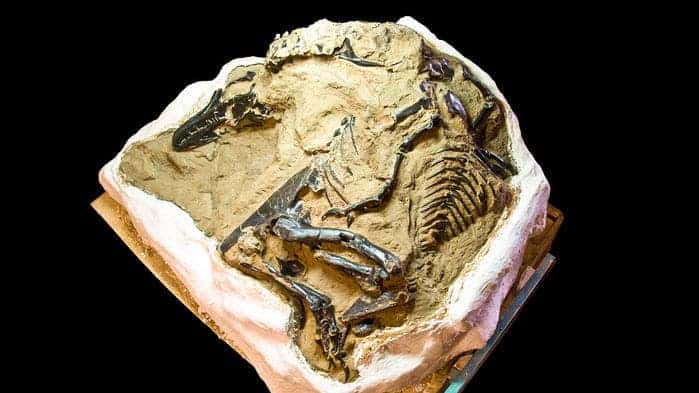Every once in a while, a scientific matter will spill into the courtroom — this is the case with the “dueling dinosaurs” fossil, which has sparked a major property rights dispute that may be extremely important for paleontology.

A fossil is a term used for any remains preserved geologically. It can be only a trace or imprint, or some type of preserved remains (typically bones or shells). Fossils may be made up of minerals, but they are not minerals themselves — at least geologically. Technically speaking, fossils are simply the remains of the hard parts of organisms or their imprints — even if sometimes, other minerals can replace the minerals that made up the original parts of the organism.
But how does this translate into ‘legalese’?
The reason for settling this debate is not just trivial. A fantastic fossil, estimated to be worth millions, is currently being judged by a court in Montana in a landmark case.
It all started in 2006, when an amateur fossil hunter discovered a cluster of fossils in Garfield County, Montana. Within this cluster, he discovered a stunning fossil: two almost intact dinosaur fossils, seemingly locked in battle. The two “dueling dinosaurs” offer one of the most detailed looks at a predator-prey interaction in dinosaurs. Needless to say, this is a goldmine for paleontologists, but its net value is also extremely high, which sparked a heated debate about who actually owns the fossil.
In Montana, the rights to a property’s mineral estates typically don’t include fossil rights, which are considered part of surface rights. This has historically been the case, and there was little need to review the situation until now. That all changed in November when the Circuit Court of Appeals sided with the mineral rights owners of the ranch where the fossils were found.
The ruling sent shocks through the paleontology world. For starters, it would strip the research world of one of the most important findings in recent years — but that’s just the start of it. It would also make digging for new fossils much more difficult, says David Polly, a former president of the Society of Vertebrate Paleontology, based in Bethesda, Maryland. It would mean that paleontologists need to navigate the land ownership as well as the mineral ownership of a parcel — the latter of which is often traced back to large corporations and can be quite difficult to trace. But it gets even worse: the ownership of fossils currently in museums would also be up for challenge, with landowners potentially having a right to claim them as their own, forcing museums to pay up if they want to keep the fossils.
At the moment, the matter lies in the hands of the Supreme Court, after the Court of Appeals recently ruled 2-1 in favor of the landowners. The former will now have to decide on whether fossils are minerals and therefore fall under mineral rights or not.
“Once upon a time, in a place now known as Montana, dinosaurs roamed the land,” wrote Eduardo Robreno, a senior Pennsylvania district judge who was on the panel by designation, in a rather colorful voice.
“On a fateful day, some 66 million years ago, two such creatures, a 22-foot-long theropod and a 28-foot-long ceratopsian, engaged in mortal combat. While history has not recorded the circumstances surrounding this encounter, the remnants of these Cretaceous species, interlocked in combat, became entombed under a pile of sandstone. That was then … this is now.”
The way the US judicial system works, the decision could serve as a precedent for rulings in other states, opening up a massive can of worms. Needless to say, paleontologists have weighed in on the issue, calling it bizarre and difficult to understand.
Essentially, it all boils down to the question of what fossils really are: are they minerals or not? The science (and the scientists) are clear on this one. The legal jury is still out.


